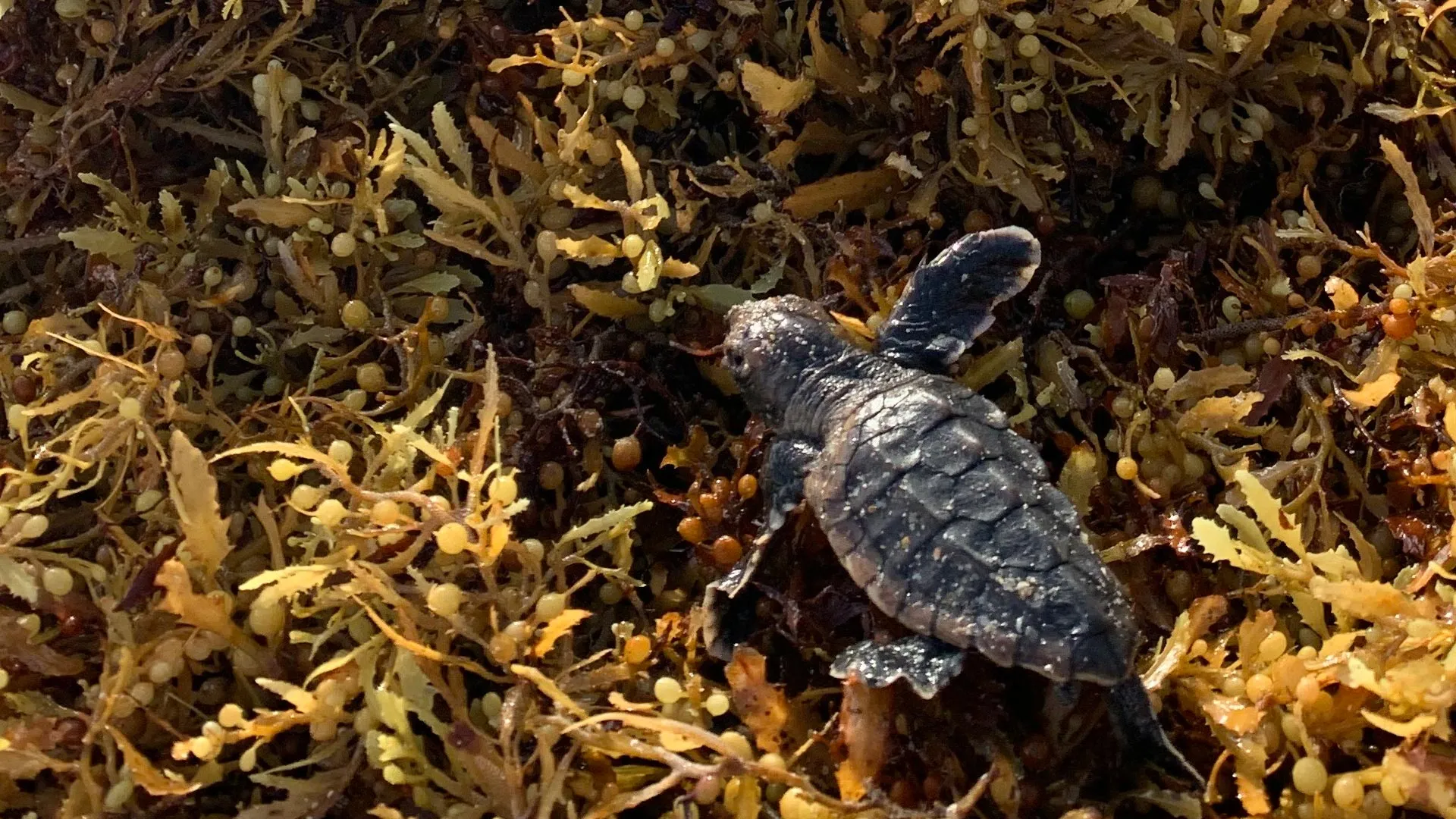Record sargassum piles trap sea turtle hatchlings on Florida beaches
- Date:
- November 24, 2025
- Source:
- Florida Atlantic University
- Summary:
- Sargassum seaweed is creating major new obstacles for sea turtle hatchlings, drastically slowing their crawl to the ocean and increasing their risk from predators and heat. Despite the physical challenge, their energy stores stay stable, suggesting the real danger lies in the delay itself.
- Share:

Every year, sea turtles emerge from nests on Florida's beaches and begin the difficult crawl from the sand to the sea -- a journey that plays a major role in whether they survive. Along the way, hatchlings must steer past artificial lighting, scattered debris, and predators such as birds and crabs. Now another challenge has intensified. Massive amounts of sargassum washing onto Florida's coastline are not only affecting beachgoers, they are also creating a serious new barrier for young sea turtles.
Scientists have long known that anything blocking a hatchling's route can slow it down and increase danger, but very little research has focused directly on the effects of sargassum. A recent study has started to provide that missing insight.
Researchers Examine How Sargassum Affects Hatchling Movement
A team from Florida Atlantic University's Charles E. Schmidt College of Science investigated whether thick sargassum deposits make the trip to the water more physically demanding -- and whether that added strain could influence a hatchling's chance of survival.
Their work examined three turtle species commonly found on Florida beaches: leatherbacks (Dermochelys coriacea), loggerheads (Caretta caretta) and green turtles (Chelonia mydas). Hatchlings were collected from Juno Beach, Jupiter and Boca Raton.
To evaluate the effect of seaweed, researchers built controlled crawlways on the sand that simulated each hatchling's natural route. At the end of a 15-meter path, they placed loose piles of sargassum up to 19 centimeters high (about 7.5 inches). A dim light several meters away guided the hatchlings forward, mimicking the glow over the ocean that turtles instinctively follow. This setup allowed the team to measure how much extra effort it took to cross sargassum while observing the turtles without disturbing their behavior.
Measuring Energy Use and Physical Condition
Once each hatchling finished the crawl, researchers checked blood glucose levels to estimate energy use. They also measured how quickly the turtles could right themselves when flipped upside down in water, which served as a simple indicator of physical condition. Sand temperature readings were taken at the start, middle and end of every crawl to document environmental conditions.
The findings, published in the Journal of Coastal Research, showed that hatchlings from all three species took much longer to complete their paths when sargassum was present. Most of this extra time came from having to climb up and over the seaweed piles. Even the lower sargassum heights tested in the study (7-9 centimeters) proved difficult, and some hatchlings from each species could not complete the climb within the time allowed.
Sargassum Significantly Slows All Three Species
Median results revealed clear slowdowns. Leatherbacks needed 54% more time to cross light sargassum and 158% more time to cross heavy sargassum. Loggerheads slowed by 91% in light conditions and 175% in heavy ones. Green turtles experienced delays of 75% in light sargassum and 159% in heavy. All species moved noticeably slower through sargassum sections, with loggerheads showing the greatest reduction in speed.
"The longer a hatchling stays on the beach, the more at risk it becomes -- not just from predators like birds and crabs, but also from overheating and dehydration, especially after sunrise," said Sarah Milton, Ph.D., senior author and chair and professor, FAU Department of Biological Sciences. "When sargassum piles are higher -- some can be over a meter high on South Florida beaches in the summer and extend for hundreds of meters down the beach -- we can expect more failed attempts, particularly when hatchlings have to cross multiple bands of seaweed just to reach the ocean."
Inversions and Added Risks for Stranded Hatchlings
The study also documented frequent inversions, where hatchlings flipped onto their backs while trying to scale the seaweed. These incidents were especially common in heavy sargassum trials. One hatchling overturned more than 20 times during a single attempt. Each inversion increased the amount of time the young turtles remained exposed on the beach, raising the risk of predation and heat-related stress.
Despite the delays and the physical effort involved, researchers found no significant differences in blood glucose levels between the hatchlings that crossed sargassum and those that did not. Glucose levels remained within normal ranges for all three species. This suggests that although the seaweed slows hatchlings and increases their vulnerability, it does not immediately drain their measurable energy reserves. Only leatherbacks in the no-crawl control group showed notably higher glucose levels, indicating that the act of crawling itself, rather than the seaweed, may have the stronger short-term physiological impact.
Expanding Sargassum Threatens Hatchling Success
"For sea turtle hatchlings, reaching the ocean is already a race against time -- and survival. Now, increasingly large mats of sargassum are adding new challenges to this critical journey," said Milton. "As these seaweed accumulations grow taller and more widespread, they risk blocking hatchlings entirely, draining their limited energy or leaving them stranded. Beyond impeding movement, sargassum may also reduce nesting space and alter incubation conditions."
The findings highlight the need for beach management strategies that adapt to the rapid spread of sargassum. Without thoughtful intervention, these dense seaweed mats could gradually undermine hatchling survival and long-term conservation efforts.
Study co-author is Abbey M. Appelt, a graduate of the FAU Department of Biological Sciences and a sea turtle nesting specialist at Ecological Associates, Inc., a South Florida environmental consulting firm.
Story Source:
Materials provided by Florida Atlantic University. Note: Content may be edited for style and length.
Journal Reference:
- Abbey M. Appelt, Sarah L. Milton. Physiological Effects of Sargassum Beach Coverage on Three Species of Sea Turtle Hatchlings. Journal of Coastal Research, 2025; 41 (6) DOI: 10.2112/JCOASTRES-D-24-00092.1
Cite This Page: